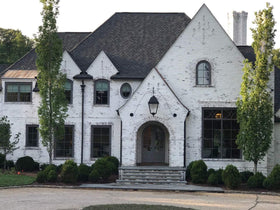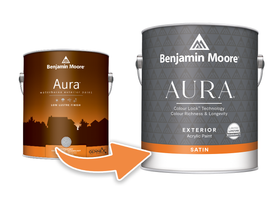When working on an exterior painting project, choosing the right paint is crucial. It may not always be obvious, but the paint used is directly proportional to how long it is going to last. Choosing the wrong paint usually means having to repaint again just after winter or summer destroys your work. In today’s post, we are going to cover a bit of the basics about how to choose the right exterior paint for your project, and how to make sure that it not only looks great, but protects the materials that you are painting on, and resists the weather’s attempts to fade and peel the paint. Remember, when buying exterior paint there is more consider than simply choosing the paint colour.
Oil-Based vs Water-Based
The first choice that presents itself is whether to choose a water-based paint, or an oil-based paint. Water-based paints, such as acrylic or latex paint, contain a pigment and binder in a water solution. These paints dry much faster, and are not flammable. Water-based paints also retain their color for a much longer time than other paints, and are breathable, so they do not trap any moisture inside of the coating. They also boast a more glossy finish than oil-based paints.
Oil-based paints, like an alkyd paint, are used when surface penetration is a key goal. They are usually composed of a pigment with a resin contained in a solvent thinner. After application, the thinner evaporates, and leaves behind a hard coating of pigment. Downsides here are that it takes a bit longer to dry, however it does leave a smoother finish, with less imperfections and better flow.
Finishes and Sheens
The next question arises when choosing the sheen, or finish. The sheen can be flat, glossy, or satin, or a mixture of a couple of different types. Choose a flat sheen for walls and fences. This will cover up any imperfections in the wood or wall that would normally be visible with a glossy sheen. Flat finishes do tend to be harder to clean, so be aware of that.
A glossy sheen will be a lot easier to clean, while being shiny and quite resistant to weathering. These are usually chosen for outdoor furniture, doors, window sills, and the like. Satin finishes are slightly glossy and good for most surfaces; they are also easy to clean and they tend to hide imperfections like a flat paint does.
Primers
Choosing a proper primer for your job depends mostly on the material being painted on, and the paint that is going to be applied over the primer. Primers are also made in both oil-based and water-based varieties. An oil-based primer can be used with either oil or water-based paint, however, a water-based primer is only recommended for use with a water-based paint. Always make sure to prime surfaces such as wood, or other stripped and bare surfaces before applying paint.
Priming a surface will allow the paint to adhere much better and last a lot longer. Be aware that there are specific types of primers used depending on the surfaces, such as wood primer, steel primer, et cetera. Some paints are actually paint and primer in one so that you don’t need to worry about choosing a primer. These are great, however, for most jobs, it’s recommended to use a separate primer coating.
In closing, there are many different formulas of paint, primer, and in-between. The one you choose should reflect the surface and location of your project. Be aware that a good exterior paint will also protect your surface materials from weather damage, and won’t peel or crack as easily. Good paints also tend to keep their color much longer, with less fading.
So remember, there is much to consider when buying exterior paint and it’s always a good idea to consult with a professional at your local paint store before making your final decision.




